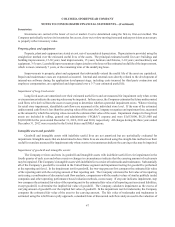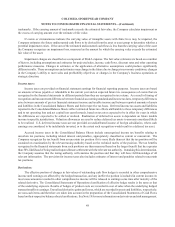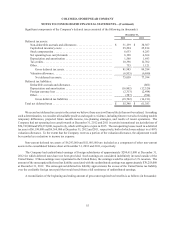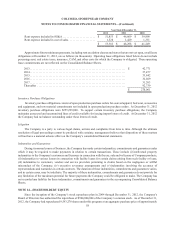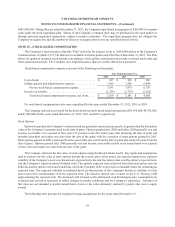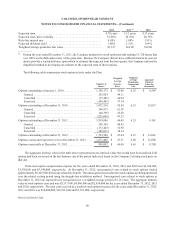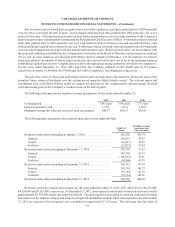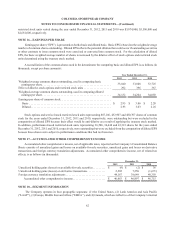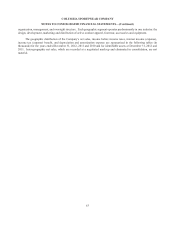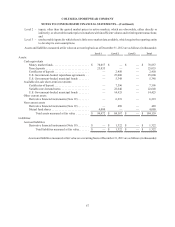Columbia Sportswear 2012 Annual Report Download - page 61
Download and view the complete annual report
Please find page 61 of the 2012 Columbia Sportswear annual report below. You can navigate through the pages in the report by either clicking on the pages listed below, or by using the keyword search tool below to find specific information within the annual report.
COLUMBIA SPORTSWEAR COMPANY
NOTES TO CONSOLIDATED FINANCIAL STATEMENTS—(Continued)
57
401(k) Profit-Sharing Plan
The Company has a 401(k) profit-sharing plan, which covers substantially all U.S. employees. Participation begins
the first day of the quarter following completion of 30 days of service. The Company may elect to make discretionary
matching and/or non-matching contributions. All Company contributions to the plan as determined by the Board of Directors
totaled $4,966,000, $5,223,000 and $4,443,000 for the years ended December 31, 2012, 2011 and 2010, respectively.
Deferred Compensation Plan
The Company sponsors a nonqualified retirement savings plan for certain senior management employees whose
contributions to the tax qualified 401(k) plan would be limited by provisions of the Internal Revenue Code. This plan allows
participants to defer receipt of a portion of their salary and incentive compensation and to receive matching contributions
for a portion of the deferred amounts. Company contributions to the plan totaled $259,000, $245,000 and $155,000 for the
years ended December 31, 2012, 2011 and 2010, respectively. Participants earn a return on their deferred compensation
based on investment earnings of participant-selected mutual funds. Changes in the market value of the participants’
investment selections are recorded as an adjustment to deferred compensation liabilities, with an offset to compensation
expense. Deferred compensation, including accumulated earnings on the participant-directed investment selections, is
distributable in cash at participant-specified dates or upon retirement, death, disability or termination of employment. At
December 31, 2012 and 2011, the liability to participants under this plan was $4,080,000 and $2,521,000, respectively, and
was recorded in other long-term liabilities. The current portion of the participant liability at December 31, 2012 and 2011
was not material.
The Company has purchased specific mutual funds in the same amounts as the participant-directed investment
selections underlying the deferred compensation liabilities. These investment securities and earnings thereon, held in an
irrevocable trust, are intended to provide a source of funds to meet the deferred compensation obligations, subject to claims
of creditors in the event of the Company’s insolvency. The mutual funds are recorded at fair value in other non-current
assets. At December 31, 2012 and 2011, the fair value of the mutual fund investments was $4,080,000 and $2,521,000,
respectively. Realized and unrealized gains and losses on the mutual fund investments are offset against gains and losses
resulting from changes in corresponding deferred compensation liabilities to participants.
NOTE 13—COMMITMENTS AND CONTINGENCIES
Operating Leases
The Company leases, among other things, retail space, office space, warehouse facilities, storage space, vehicles and
equipment. Generally, the base lease terms are between 5 and 10 years. Certain lease agreements contain scheduled rent
escalation clauses in their future minimum lease payments. Future minimum lease payments are recognized on a straight-
line basis over the minimum lease term and the pro rata portion of scheduled rent escalations is included in other long-term
liabilities. Certain retail space lease agreements provide for additional rents based on a percentage of annual sales in excess
of stipulated minimums (“percentage rent”). Certain lease agreements require the Company to pay real estate taxes,
insurance, common area maintenance (“CAM”), and other costs, collectively referred to as operating costs, in addition to
base rent. Percentage rent and operating costs are recognized as incurred in SG&A expense in the Consolidated Statements
of Operations. Certain lease agreements also contain lease incentives, such as tenant improvement allowances and rent
holidays. The Company recognizes the benefits related to the lease incentives on a straight-line basis over the applicable
lease term.
Rent expense, including percentage rent but excluding operating costs for which the Company is obligated, consisted
of the following (in thousands):


